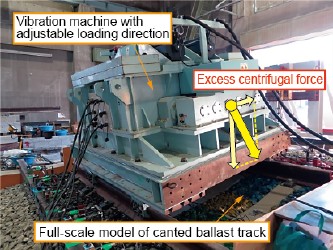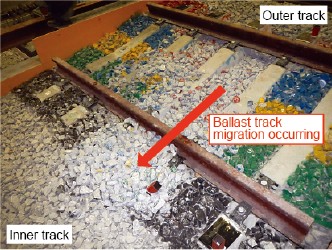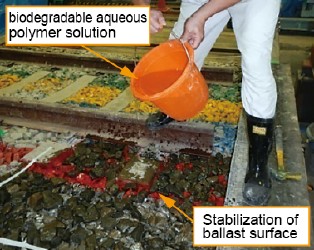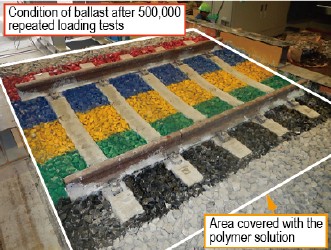15.Countermeasure work on ballasted Shinkansen track to prevent ballast migration
On ballasted Shinkansen track, in curves with large cant the surface ballast flows from the outer rail towards the inner rail due to the passage of trains, which can cause “ballast migration”, and lead to a frequent need for maintenance work.
As a measure to counteract this phenomenom, a vibration machine was employed with controllable load direction, to conduct repetitive tests taking into account the excessive centrifugal force which occurs when a train runs through a curve (Fig. 1). The results of these tests showed that it was possible to reproduce ballast migration through tests conducted inside (Fig. 2).
Results from investigations into the mechanisms producing ballast migration revealed that dynamic displacement of the sleepers was causing the ballast to shake, and that using rectangular section sleepers and track bed improvement were effective. An additional low-cost countermeasure involved using a biodegradable aqueous polymer solution to stabilise the surface of the ballast (Fig.3 and 4). This method is approximately 50% more economical than frequent ballast scraping work, and allows tamping once work has been completed.
Other Contents
- 13.Sheet pile reinforcement work on pile foundations during ground liquefaction
- 14.Countermeasure for fatigue cracks around I-beam bridge supports
- 15.Countermeasure work on ballasted Shinkansen track to prevent ballast migration
- 16.Method for detecting damage and repairing slab track cement asphalt mortar layers
- 17.Decision-making support system for planning replacement of wooden-sleepers with PC sleepers in curved sections
- 18.System for inspecting obstruction warning signals
- 19.Possibility of practical application of a 920MHz bandwidth network
- 13.Sheet pile reinforcement work on pile foundations during ground liquefaction
- 14.Countermeasure for fatigue cracks around I-beam bridge supports
- 15.Countermeasure work on ballasted Shinkansen track to prevent ballast migration
- 16.Method for detecting damage and repairing slab track cement asphalt mortar layers
- 17.Decision-making support system for planning replacement of wooden-sleepers with PC sleepers in curved sections
- 18.System for inspecting obstruction warning signals
- 19.Possibility of practical application of a 920MHz bandwidth network




